Literature Review: Barriers to T1D Self-Management in Adolescents
VerifiedAdded on 2023/06/08
|43
|12825
|130
Literature Review
AI Summary
This literature review critically evaluates existing research on the barriers to Type 1 diabetes (T1D) self-management in adolescents. The study highlights the increasing prevalence of T1D in this age group and the unique challenges they face in managing the condition. The review synthesizes findings from databases like CINAHL, PubMed, and Medline, identifying five key themes: social barriers (peer influence, bullying), treatment regimen-related barriers, psychological barriers, and person-centered barriers. These themes underscore the impact of environmental, social, psychological, and personal factors on self-management. The review emphasizes the need for interventions, such as school-based programs, to address these challenges and promote effective self-management strategies. Furthermore, the importance of patient-provider communication is highlighted to address poor perceptions of treatment and knowledge gaps. The review aims to improve the quality of life for adolescents affected by T1D by understanding and addressing the factors influencing self-management.
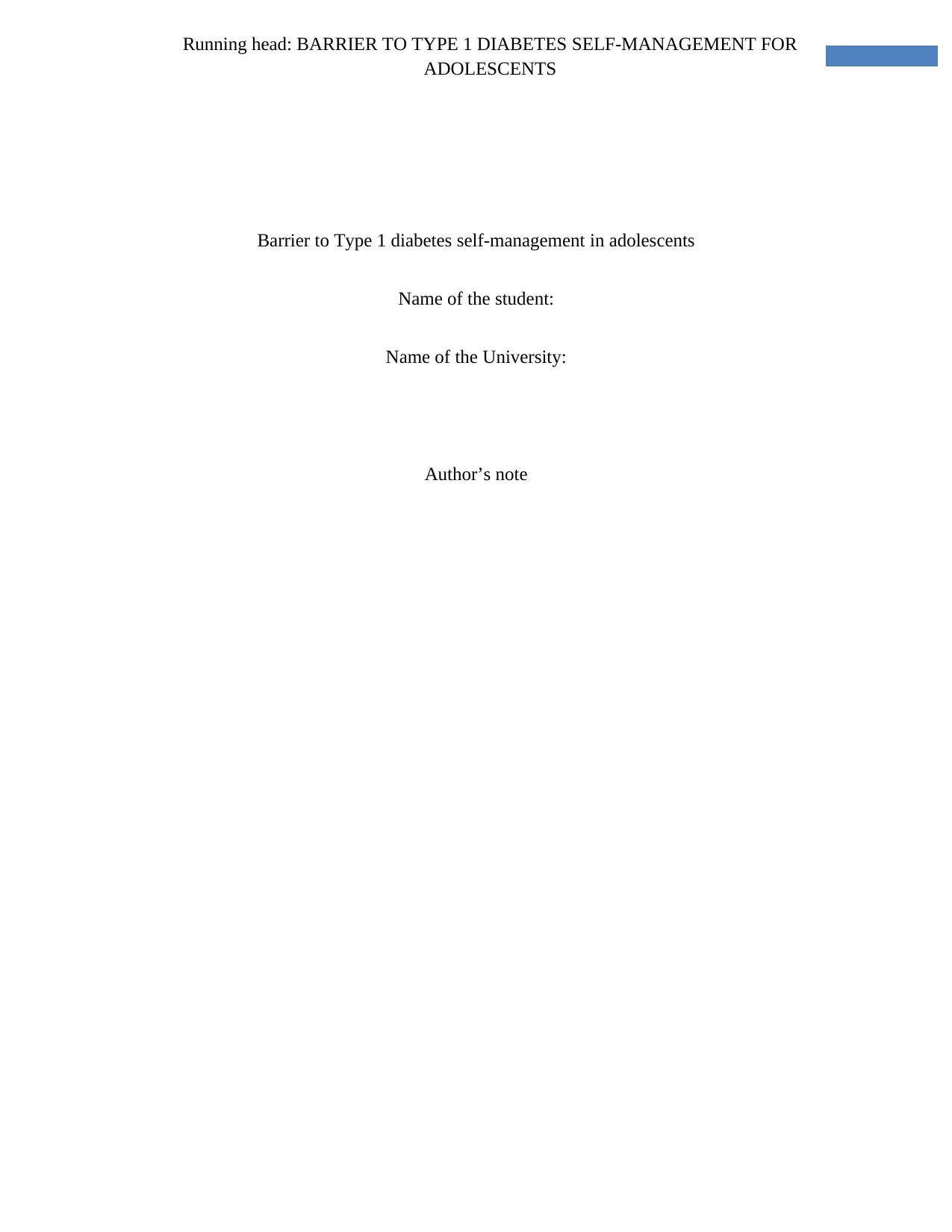
Running head: BARRIER TO TYPE 1 DIABETES SELF-MANAGEMENT FOR
ADOLESCENTS
Barrier to Type 1 diabetes self-management in adolescents
Name of the student:
Name of the University:
Author’s note
ADOLESCENTS
Barrier to Type 1 diabetes self-management in adolescents
Name of the student:
Name of the University:
Author’s note
Paraphrase This Document
Need a fresh take? Get an instant paraphrase of this document with our AI Paraphraser
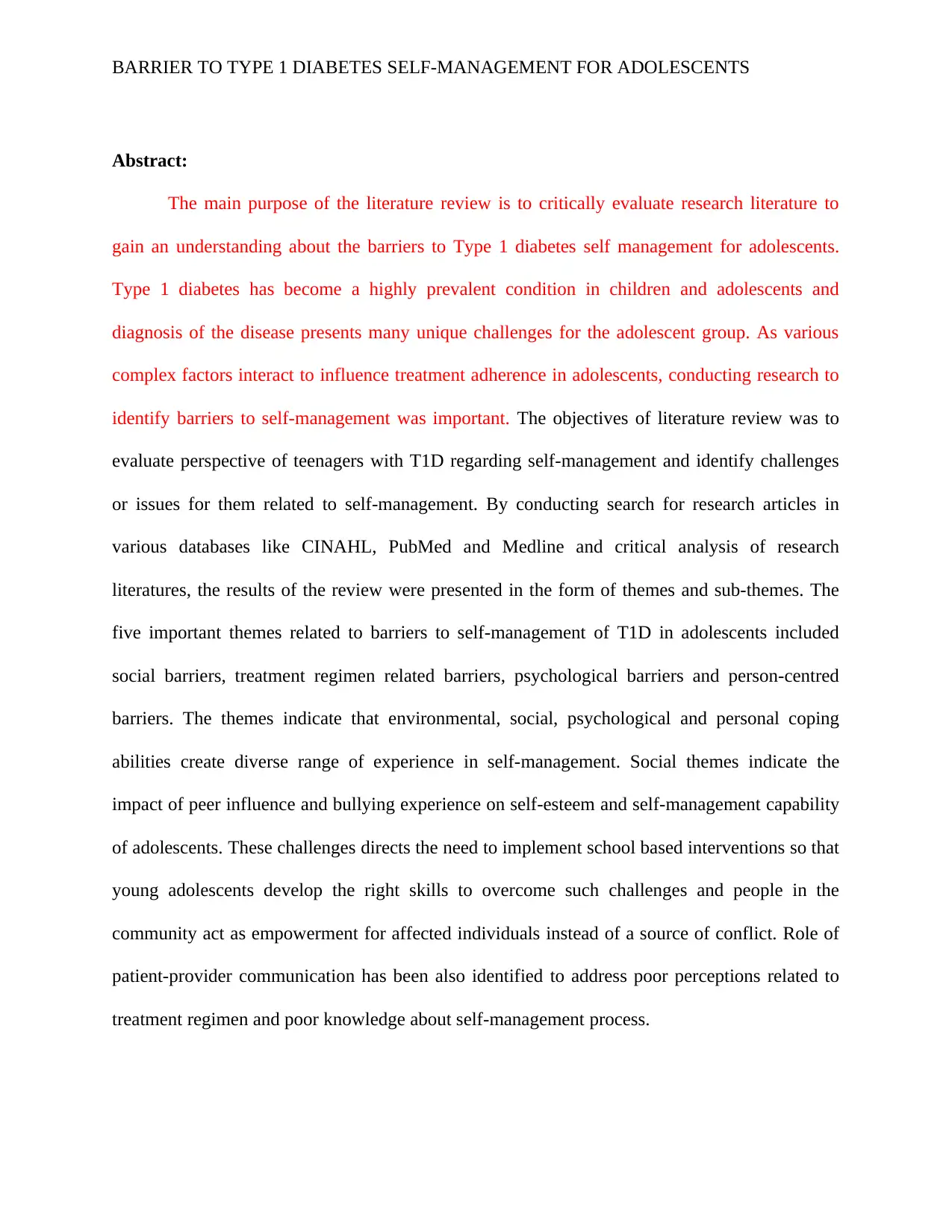
BARRIER TO TYPE 1 DIABETES SELF-MANAGEMENT FOR ADOLESCENTS
Abstract:
The main purpose of the literature review is to critically evaluate research literature to
gain an understanding about the barriers to Type 1 diabetes self management for adolescents.
Type 1 diabetes has become a highly prevalent condition in children and adolescents and
diagnosis of the disease presents many unique challenges for the adolescent group. As various
complex factors interact to influence treatment adherence in adolescents, conducting research to
identify barriers to self-management was important. The objectives of literature review was to
evaluate perspective of teenagers with T1D regarding self-management and identify challenges
or issues for them related to self-management. By conducting search for research articles in
various databases like CINAHL, PubMed and Medline and critical analysis of research
literatures, the results of the review were presented in the form of themes and sub-themes. The
five important themes related to barriers to self-management of T1D in adolescents included
social barriers, treatment regimen related barriers, psychological barriers and person-centred
barriers. The themes indicate that environmental, social, psychological and personal coping
abilities create diverse range of experience in self-management. Social themes indicate the
impact of peer influence and bullying experience on self-esteem and self-management capability
of adolescents. These challenges directs the need to implement school based interventions so that
young adolescents develop the right skills to overcome such challenges and people in the
community act as empowerment for affected individuals instead of a source of conflict. Role of
patient-provider communication has been also identified to address poor perceptions related to
treatment regimen and poor knowledge about self-management process.
Abstract:
The main purpose of the literature review is to critically evaluate research literature to
gain an understanding about the barriers to Type 1 diabetes self management for adolescents.
Type 1 diabetes has become a highly prevalent condition in children and adolescents and
diagnosis of the disease presents many unique challenges for the adolescent group. As various
complex factors interact to influence treatment adherence in adolescents, conducting research to
identify barriers to self-management was important. The objectives of literature review was to
evaluate perspective of teenagers with T1D regarding self-management and identify challenges
or issues for them related to self-management. By conducting search for research articles in
various databases like CINAHL, PubMed and Medline and critical analysis of research
literatures, the results of the review were presented in the form of themes and sub-themes. The
five important themes related to barriers to self-management of T1D in adolescents included
social barriers, treatment regimen related barriers, psychological barriers and person-centred
barriers. The themes indicate that environmental, social, psychological and personal coping
abilities create diverse range of experience in self-management. Social themes indicate the
impact of peer influence and bullying experience on self-esteem and self-management capability
of adolescents. These challenges directs the need to implement school based interventions so that
young adolescents develop the right skills to overcome such challenges and people in the
community act as empowerment for affected individuals instead of a source of conflict. Role of
patient-provider communication has been also identified to address poor perceptions related to
treatment regimen and poor knowledge about self-management process.

BARRIER TO TYPE 1 DIABETES SELF-MANAGEMENT FOR ADOLESCENTS
⊘ This is a preview!⊘
Do you want full access?
Subscribe today to unlock all pages.

Trusted by 1+ million students worldwide
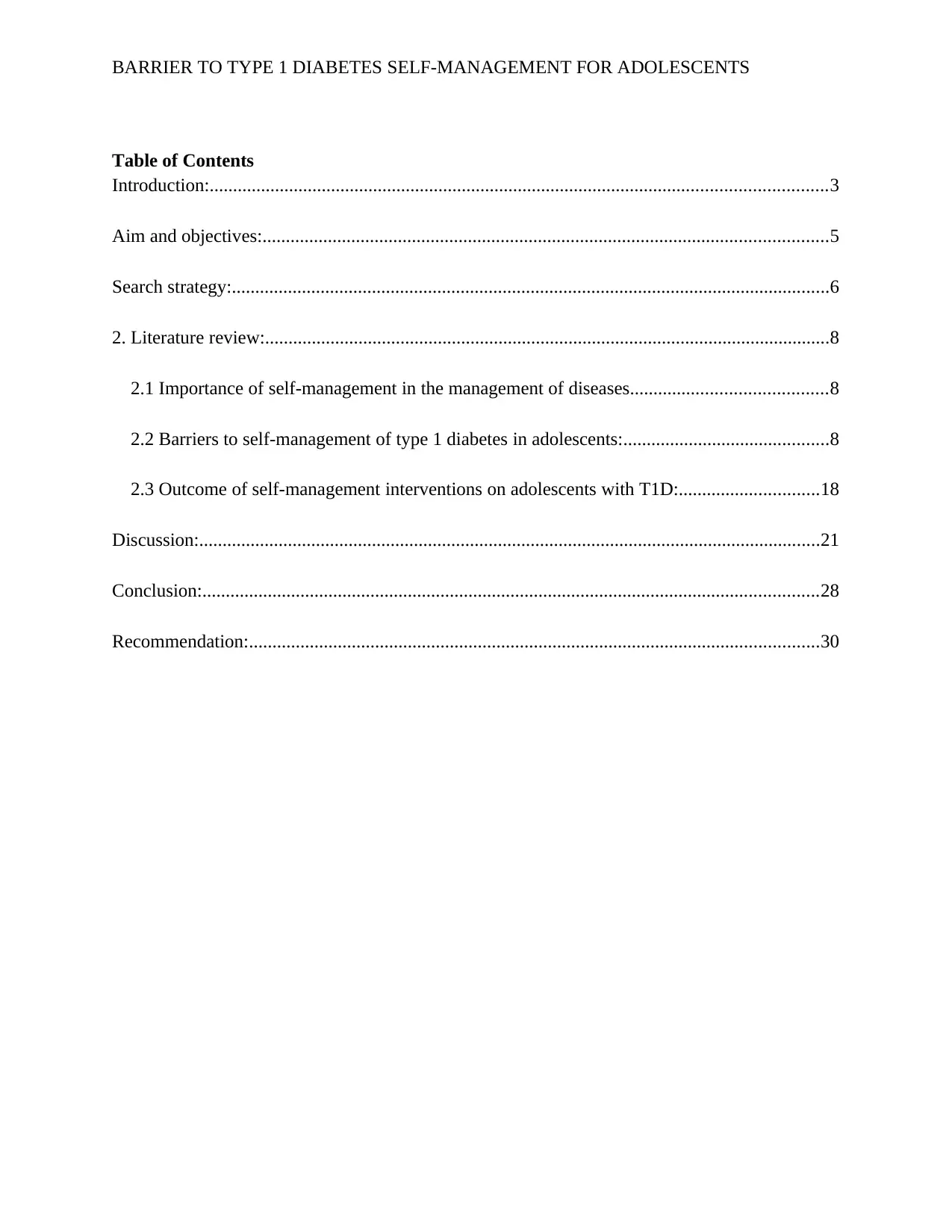
BARRIER TO TYPE 1 DIABETES SELF-MANAGEMENT FOR ADOLESCENTS
Table of Contents
Introduction:....................................................................................................................................3
Aim and objectives:.........................................................................................................................5
Search strategy:................................................................................................................................6
2. Literature review:.........................................................................................................................8
2.1 Importance of self-management in the management of diseases..........................................8
2.2 Barriers to self-management of type 1 diabetes in adolescents:............................................8
2.3 Outcome of self-management interventions on adolescents with T1D:..............................18
Discussion:.....................................................................................................................................21
Conclusion:....................................................................................................................................28
Recommendation:..........................................................................................................................30
Table of Contents
Introduction:....................................................................................................................................3
Aim and objectives:.........................................................................................................................5
Search strategy:................................................................................................................................6
2. Literature review:.........................................................................................................................8
2.1 Importance of self-management in the management of diseases..........................................8
2.2 Barriers to self-management of type 1 diabetes in adolescents:............................................8
2.3 Outcome of self-management interventions on adolescents with T1D:..............................18
Discussion:.....................................................................................................................................21
Conclusion:....................................................................................................................................28
Recommendation:..........................................................................................................................30
Paraphrase This Document
Need a fresh take? Get an instant paraphrase of this document with our AI Paraphraser
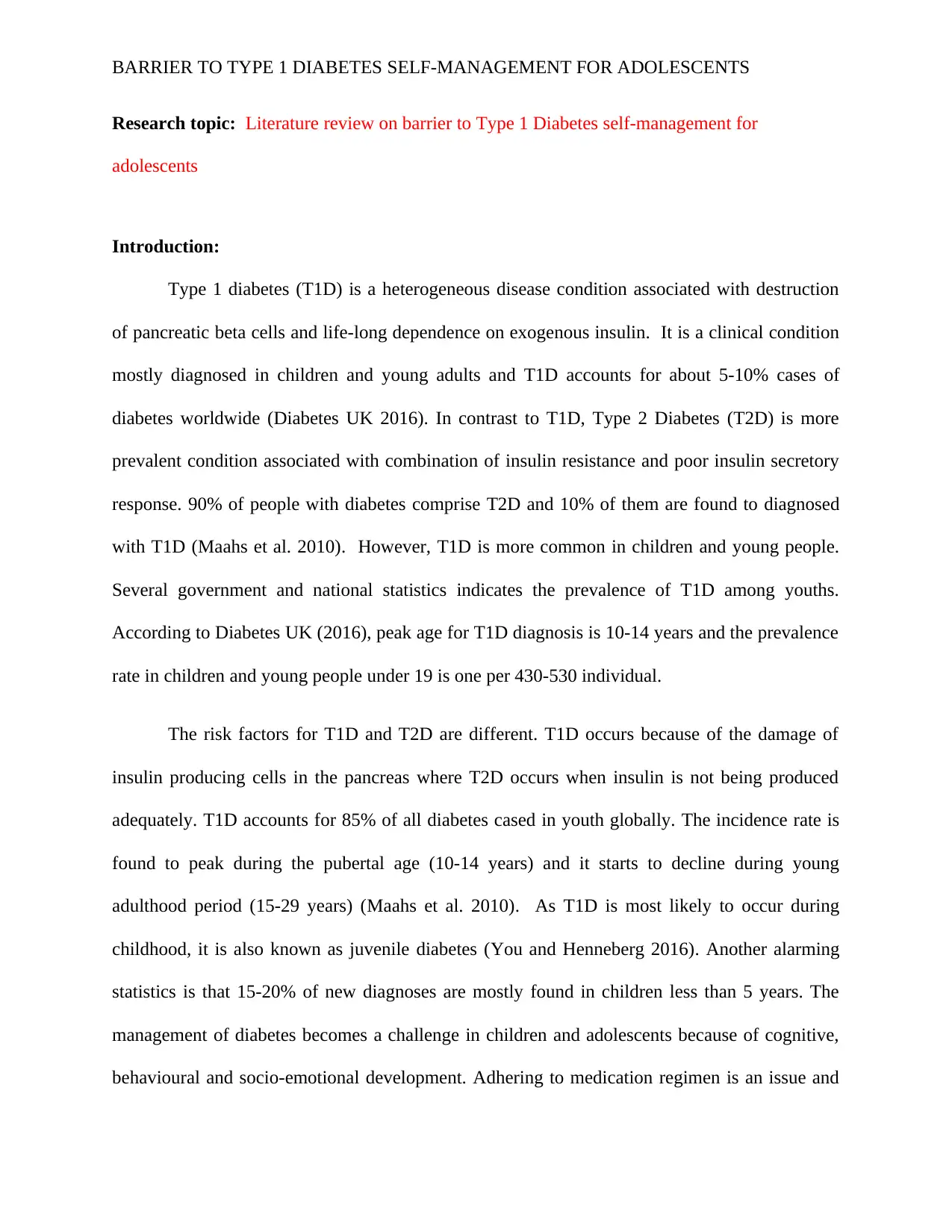
BARRIER TO TYPE 1 DIABETES SELF-MANAGEMENT FOR ADOLESCENTS
Research topic: Literature review on barrier to Type 1 Diabetes self-management for
adolescents
Introduction:
Type 1 diabetes (T1D) is a heterogeneous disease condition associated with destruction
of pancreatic beta cells and life-long dependence on exogenous insulin. It is a clinical condition
mostly diagnosed in children and young adults and T1D accounts for about 5-10% cases of
diabetes worldwide (Diabetes UK 2016). In contrast to T1D, Type 2 Diabetes (T2D) is more
prevalent condition associated with combination of insulin resistance and poor insulin secretory
response. 90% of people with diabetes comprise T2D and 10% of them are found to diagnosed
with T1D (Maahs et al. 2010). However, T1D is more common in children and young people.
Several government and national statistics indicates the prevalence of T1D among youths.
According to Diabetes UK (2016), peak age for T1D diagnosis is 10-14 years and the prevalence
rate in children and young people under 19 is one per 430-530 individual.
The risk factors for T1D and T2D are different. T1D occurs because of the damage of
insulin producing cells in the pancreas where T2D occurs when insulin is not being produced
adequately. T1D accounts for 85% of all diabetes cased in youth globally. The incidence rate is
found to peak during the pubertal age (10-14 years) and it starts to decline during young
adulthood period (15-29 years) (Maahs et al. 2010). As T1D is most likely to occur during
childhood, it is also known as juvenile diabetes (You and Henneberg 2016). Another alarming
statistics is that 15-20% of new diagnoses are mostly found in children less than 5 years. The
management of diabetes becomes a challenge in children and adolescents because of cognitive,
behavioural and socio-emotional development. Adhering to medication regimen is an issue and
Research topic: Literature review on barrier to Type 1 Diabetes self-management for
adolescents
Introduction:
Type 1 diabetes (T1D) is a heterogeneous disease condition associated with destruction
of pancreatic beta cells and life-long dependence on exogenous insulin. It is a clinical condition
mostly diagnosed in children and young adults and T1D accounts for about 5-10% cases of
diabetes worldwide (Diabetes UK 2016). In contrast to T1D, Type 2 Diabetes (T2D) is more
prevalent condition associated with combination of insulin resistance and poor insulin secretory
response. 90% of people with diabetes comprise T2D and 10% of them are found to diagnosed
with T1D (Maahs et al. 2010). However, T1D is more common in children and young people.
Several government and national statistics indicates the prevalence of T1D among youths.
According to Diabetes UK (2016), peak age for T1D diagnosis is 10-14 years and the prevalence
rate in children and young people under 19 is one per 430-530 individual.
The risk factors for T1D and T2D are different. T1D occurs because of the damage of
insulin producing cells in the pancreas where T2D occurs when insulin is not being produced
adequately. T1D accounts for 85% of all diabetes cased in youth globally. The incidence rate is
found to peak during the pubertal age (10-14 years) and it starts to decline during young
adulthood period (15-29 years) (Maahs et al. 2010). As T1D is most likely to occur during
childhood, it is also known as juvenile diabetes (You and Henneberg 2016). Another alarming
statistics is that 15-20% of new diagnoses are mostly found in children less than 5 years. The
management of diabetes becomes a challenge in children and adolescents because of cognitive,
behavioural and socio-emotional development. Adhering to medication regimen is an issue and
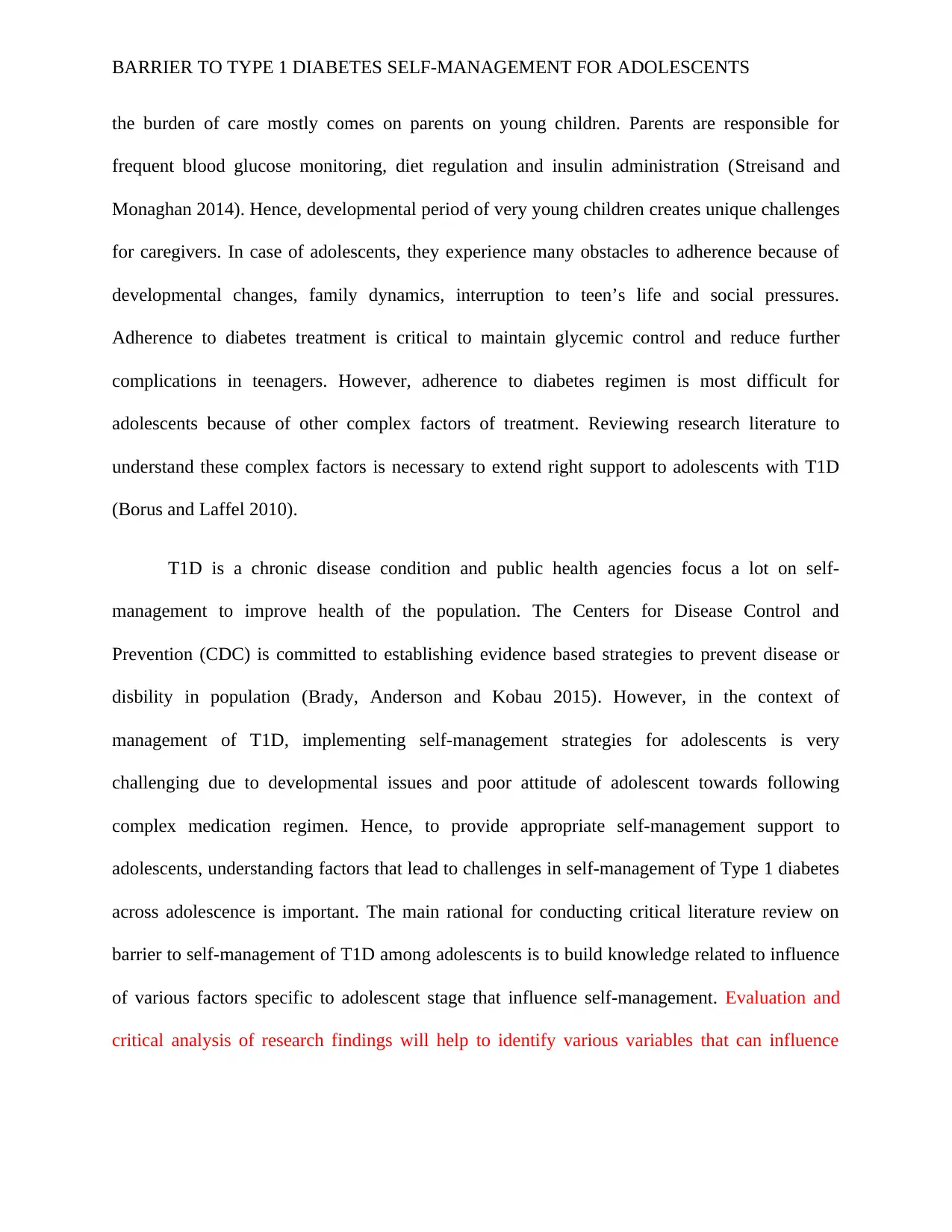
BARRIER TO TYPE 1 DIABETES SELF-MANAGEMENT FOR ADOLESCENTS
the burden of care mostly comes on parents on young children. Parents are responsible for
frequent blood glucose monitoring, diet regulation and insulin administration (Streisand and
Monaghan 2014). Hence, developmental period of very young children creates unique challenges
for caregivers. In case of adolescents, they experience many obstacles to adherence because of
developmental changes, family dynamics, interruption to teen’s life and social pressures.
Adherence to diabetes treatment is critical to maintain glycemic control and reduce further
complications in teenagers. However, adherence to diabetes regimen is most difficult for
adolescents because of other complex factors of treatment. Reviewing research literature to
understand these complex factors is necessary to extend right support to adolescents with T1D
(Borus and Laffel 2010).
T1D is a chronic disease condition and public health agencies focus a lot on self-
management to improve health of the population. The Centers for Disease Control and
Prevention (CDC) is committed to establishing evidence based strategies to prevent disease or
disbility in population (Brady, Anderson and Kobau 2015). However, in the context of
management of T1D, implementing self-management strategies for adolescents is very
challenging due to developmental issues and poor attitude of adolescent towards following
complex medication regimen. Hence, to provide appropriate self-management support to
adolescents, understanding factors that lead to challenges in self-management of Type 1 diabetes
across adolescence is important. The main rational for conducting critical literature review on
barrier to self-management of T1D among adolescents is to build knowledge related to influence
of various factors specific to adolescent stage that influence self-management. Evaluation and
critical analysis of research findings will help to identify various variables that can influence
the burden of care mostly comes on parents on young children. Parents are responsible for
frequent blood glucose monitoring, diet regulation and insulin administration (Streisand and
Monaghan 2014). Hence, developmental period of very young children creates unique challenges
for caregivers. In case of adolescents, they experience many obstacles to adherence because of
developmental changes, family dynamics, interruption to teen’s life and social pressures.
Adherence to diabetes treatment is critical to maintain glycemic control and reduce further
complications in teenagers. However, adherence to diabetes regimen is most difficult for
adolescents because of other complex factors of treatment. Reviewing research literature to
understand these complex factors is necessary to extend right support to adolescents with T1D
(Borus and Laffel 2010).
T1D is a chronic disease condition and public health agencies focus a lot on self-
management to improve health of the population. The Centers for Disease Control and
Prevention (CDC) is committed to establishing evidence based strategies to prevent disease or
disbility in population (Brady, Anderson and Kobau 2015). However, in the context of
management of T1D, implementing self-management strategies for adolescents is very
challenging due to developmental issues and poor attitude of adolescent towards following
complex medication regimen. Hence, to provide appropriate self-management support to
adolescents, understanding factors that lead to challenges in self-management of Type 1 diabetes
across adolescence is important. The main rational for conducting critical literature review on
barrier to self-management of T1D among adolescents is to build knowledge related to influence
of various factors specific to adolescent stage that influence self-management. Evaluation and
critical analysis of research findings will help to identify various variables that can influence
⊘ This is a preview!⊘
Do you want full access?
Subscribe today to unlock all pages.

Trusted by 1+ million students worldwide
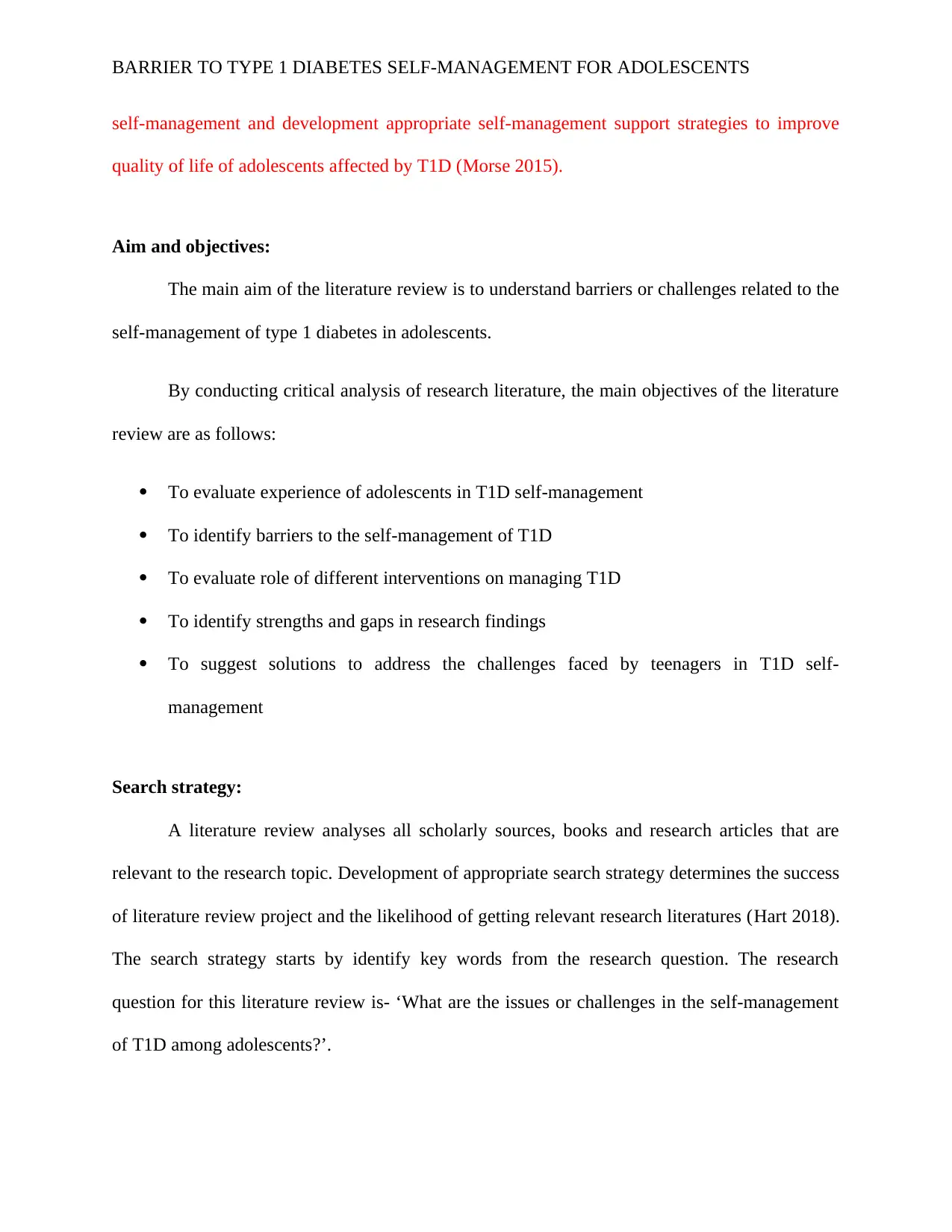
BARRIER TO TYPE 1 DIABETES SELF-MANAGEMENT FOR ADOLESCENTS
self-management and development appropriate self-management support strategies to improve
quality of life of adolescents affected by T1D (Morse 2015).
Aim and objectives:
The main aim of the literature review is to understand barriers or challenges related to the
self-management of type 1 diabetes in adolescents.
By conducting critical analysis of research literature, the main objectives of the literature
review are as follows:
To evaluate experience of adolescents in T1D self-management
To identify barriers to the self-management of T1D
To evaluate role of different interventions on managing T1D
To identify strengths and gaps in research findings
To suggest solutions to address the challenges faced by teenagers in T1D self-
management
Search strategy:
A literature review analyses all scholarly sources, books and research articles that are
relevant to the research topic. Development of appropriate search strategy determines the success
of literature review project and the likelihood of getting relevant research literatures (Hart 2018).
The search strategy starts by identify key words from the research question. The research
question for this literature review is- ‘What are the issues or challenges in the self-management
of T1D among adolescents?’.
self-management and development appropriate self-management support strategies to improve
quality of life of adolescents affected by T1D (Morse 2015).
Aim and objectives:
The main aim of the literature review is to understand barriers or challenges related to the
self-management of type 1 diabetes in adolescents.
By conducting critical analysis of research literature, the main objectives of the literature
review are as follows:
To evaluate experience of adolescents in T1D self-management
To identify barriers to the self-management of T1D
To evaluate role of different interventions on managing T1D
To identify strengths and gaps in research findings
To suggest solutions to address the challenges faced by teenagers in T1D self-
management
Search strategy:
A literature review analyses all scholarly sources, books and research articles that are
relevant to the research topic. Development of appropriate search strategy determines the success
of literature review project and the likelihood of getting relevant research literatures (Hart 2018).
The search strategy starts by identify key words from the research question. The research
question for this literature review is- ‘What are the issues or challenges in the self-management
of T1D among adolescents?’.
Paraphrase This Document
Need a fresh take? Get an instant paraphrase of this document with our AI Paraphraser
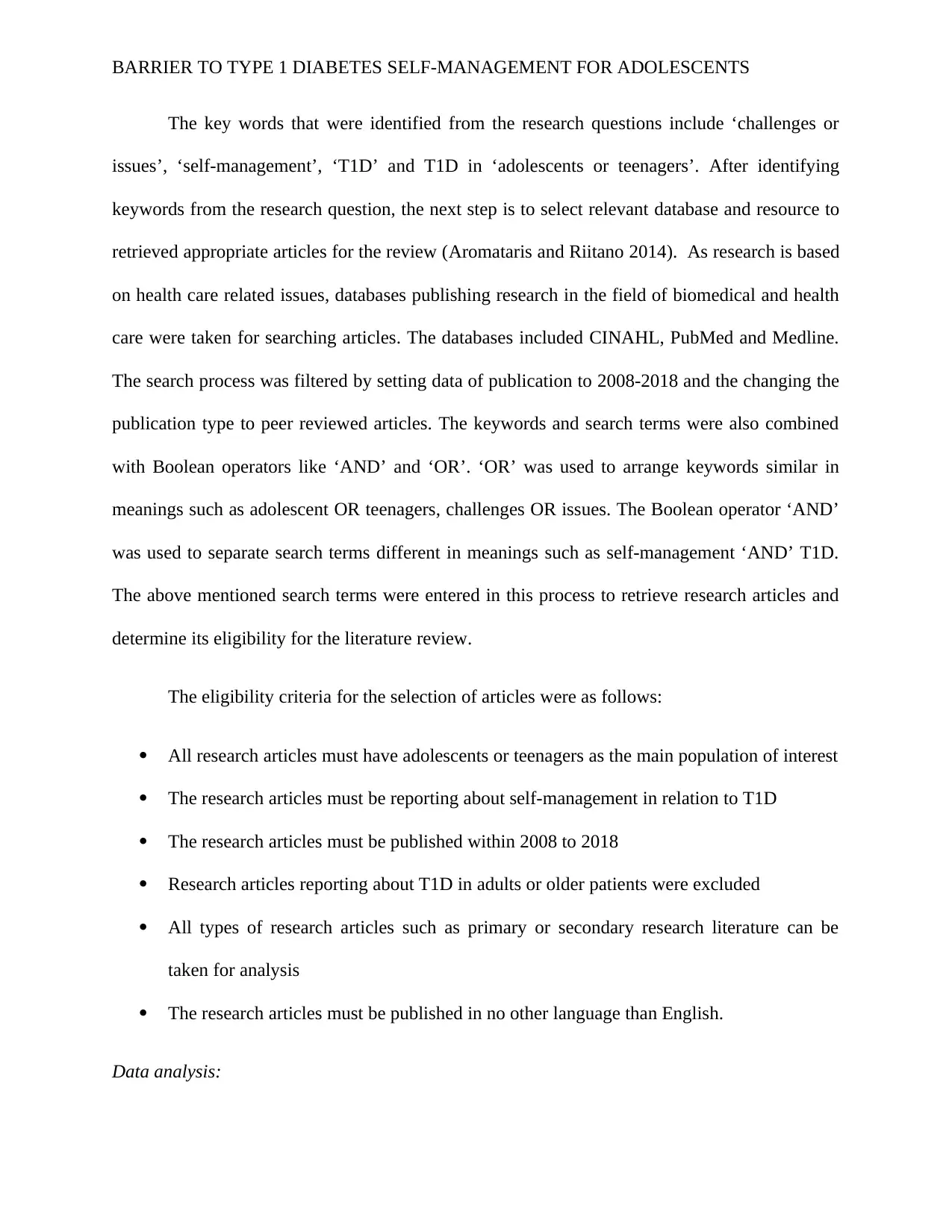
BARRIER TO TYPE 1 DIABETES SELF-MANAGEMENT FOR ADOLESCENTS
The key words that were identified from the research questions include ‘challenges or
issues’, ‘self-management’, ‘T1D’ and T1D in ‘adolescents or teenagers’. After identifying
keywords from the research question, the next step is to select relevant database and resource to
retrieved appropriate articles for the review (Aromataris and Riitano 2014). As research is based
on health care related issues, databases publishing research in the field of biomedical and health
care were taken for searching articles. The databases included CINAHL, PubMed and Medline.
The search process was filtered by setting data of publication to 2008-2018 and the changing the
publication type to peer reviewed articles. The keywords and search terms were also combined
with Boolean operators like ‘AND’ and ‘OR’. ‘OR’ was used to arrange keywords similar in
meanings such as adolescent OR teenagers, challenges OR issues. The Boolean operator ‘AND’
was used to separate search terms different in meanings such as self-management ‘AND’ T1D.
The above mentioned search terms were entered in this process to retrieve research articles and
determine its eligibility for the literature review.
The eligibility criteria for the selection of articles were as follows:
All research articles must have adolescents or teenagers as the main population of interest
The research articles must be reporting about self-management in relation to T1D
The research articles must be published within 2008 to 2018
Research articles reporting about T1D in adults or older patients were excluded
All types of research articles such as primary or secondary research literature can be
taken for analysis
The research articles must be published in no other language than English.
Data analysis:
The key words that were identified from the research questions include ‘challenges or
issues’, ‘self-management’, ‘T1D’ and T1D in ‘adolescents or teenagers’. After identifying
keywords from the research question, the next step is to select relevant database and resource to
retrieved appropriate articles for the review (Aromataris and Riitano 2014). As research is based
on health care related issues, databases publishing research in the field of biomedical and health
care were taken for searching articles. The databases included CINAHL, PubMed and Medline.
The search process was filtered by setting data of publication to 2008-2018 and the changing the
publication type to peer reviewed articles. The keywords and search terms were also combined
with Boolean operators like ‘AND’ and ‘OR’. ‘OR’ was used to arrange keywords similar in
meanings such as adolescent OR teenagers, challenges OR issues. The Boolean operator ‘AND’
was used to separate search terms different in meanings such as self-management ‘AND’ T1D.
The above mentioned search terms were entered in this process to retrieve research articles and
determine its eligibility for the literature review.
The eligibility criteria for the selection of articles were as follows:
All research articles must have adolescents or teenagers as the main population of interest
The research articles must be reporting about self-management in relation to T1D
The research articles must be published within 2008 to 2018
Research articles reporting about T1D in adults or older patients were excluded
All types of research articles such as primary or secondary research literature can be
taken for analysis
The research articles must be published in no other language than English.
Data analysis:
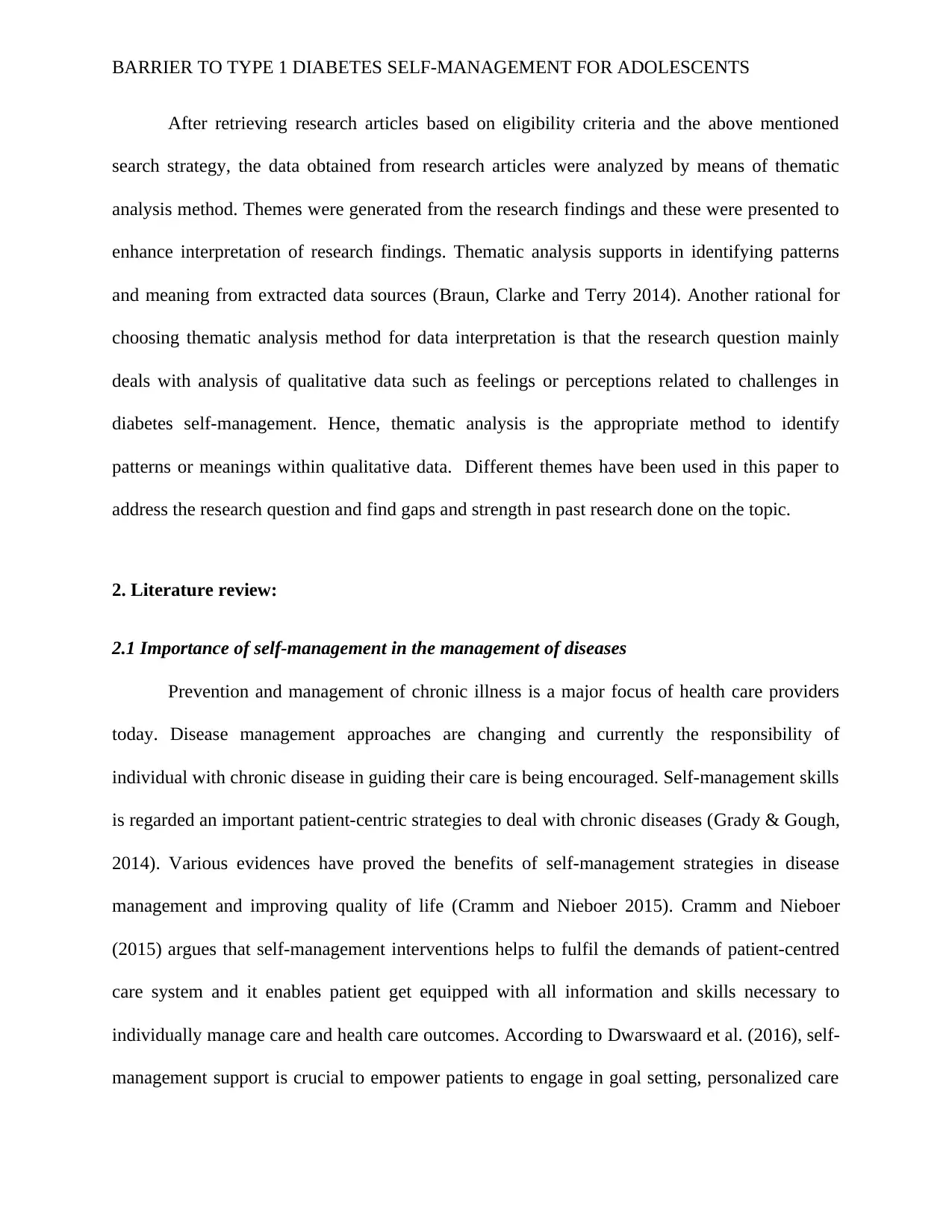
BARRIER TO TYPE 1 DIABETES SELF-MANAGEMENT FOR ADOLESCENTS
After retrieving research articles based on eligibility criteria and the above mentioned
search strategy, the data obtained from research articles were analyzed by means of thematic
analysis method. Themes were generated from the research findings and these were presented to
enhance interpretation of research findings. Thematic analysis supports in identifying patterns
and meaning from extracted data sources (Braun, Clarke and Terry 2014). Another rational for
choosing thematic analysis method for data interpretation is that the research question mainly
deals with analysis of qualitative data such as feelings or perceptions related to challenges in
diabetes self-management. Hence, thematic analysis is the appropriate method to identify
patterns or meanings within qualitative data. Different themes have been used in this paper to
address the research question and find gaps and strength in past research done on the topic.
2. Literature review:
2.1 Importance of self-management in the management of diseases
Prevention and management of chronic illness is a major focus of health care providers
today. Disease management approaches are changing and currently the responsibility of
individual with chronic disease in guiding their care is being encouraged. Self-management skills
is regarded an important patient-centric strategies to deal with chronic diseases (Grady & Gough,
2014). Various evidences have proved the benefits of self-management strategies in disease
management and improving quality of life (Cramm and Nieboer 2015). Cramm and Nieboer
(2015) argues that self-management interventions helps to fulfil the demands of patient-centred
care system and it enables patient get equipped with all information and skills necessary to
individually manage care and health care outcomes. According to Dwarswaard et al. (2016), self-
management support is crucial to empower patients to engage in goal setting, personalized care
After retrieving research articles based on eligibility criteria and the above mentioned
search strategy, the data obtained from research articles were analyzed by means of thematic
analysis method. Themes were generated from the research findings and these were presented to
enhance interpretation of research findings. Thematic analysis supports in identifying patterns
and meaning from extracted data sources (Braun, Clarke and Terry 2014). Another rational for
choosing thematic analysis method for data interpretation is that the research question mainly
deals with analysis of qualitative data such as feelings or perceptions related to challenges in
diabetes self-management. Hence, thematic analysis is the appropriate method to identify
patterns or meanings within qualitative data. Different themes have been used in this paper to
address the research question and find gaps and strength in past research done on the topic.
2. Literature review:
2.1 Importance of self-management in the management of diseases
Prevention and management of chronic illness is a major focus of health care providers
today. Disease management approaches are changing and currently the responsibility of
individual with chronic disease in guiding their care is being encouraged. Self-management skills
is regarded an important patient-centric strategies to deal with chronic diseases (Grady & Gough,
2014). Various evidences have proved the benefits of self-management strategies in disease
management and improving quality of life (Cramm and Nieboer 2015). Cramm and Nieboer
(2015) argues that self-management interventions helps to fulfil the demands of patient-centred
care system and it enables patient get equipped with all information and skills necessary to
individually manage care and health care outcomes. According to Dwarswaard et al. (2016), self-
management support is crucial to empower patients to engage in goal setting, personalized care
⊘ This is a preview!⊘
Do you want full access?
Subscribe today to unlock all pages.

Trusted by 1+ million students worldwide
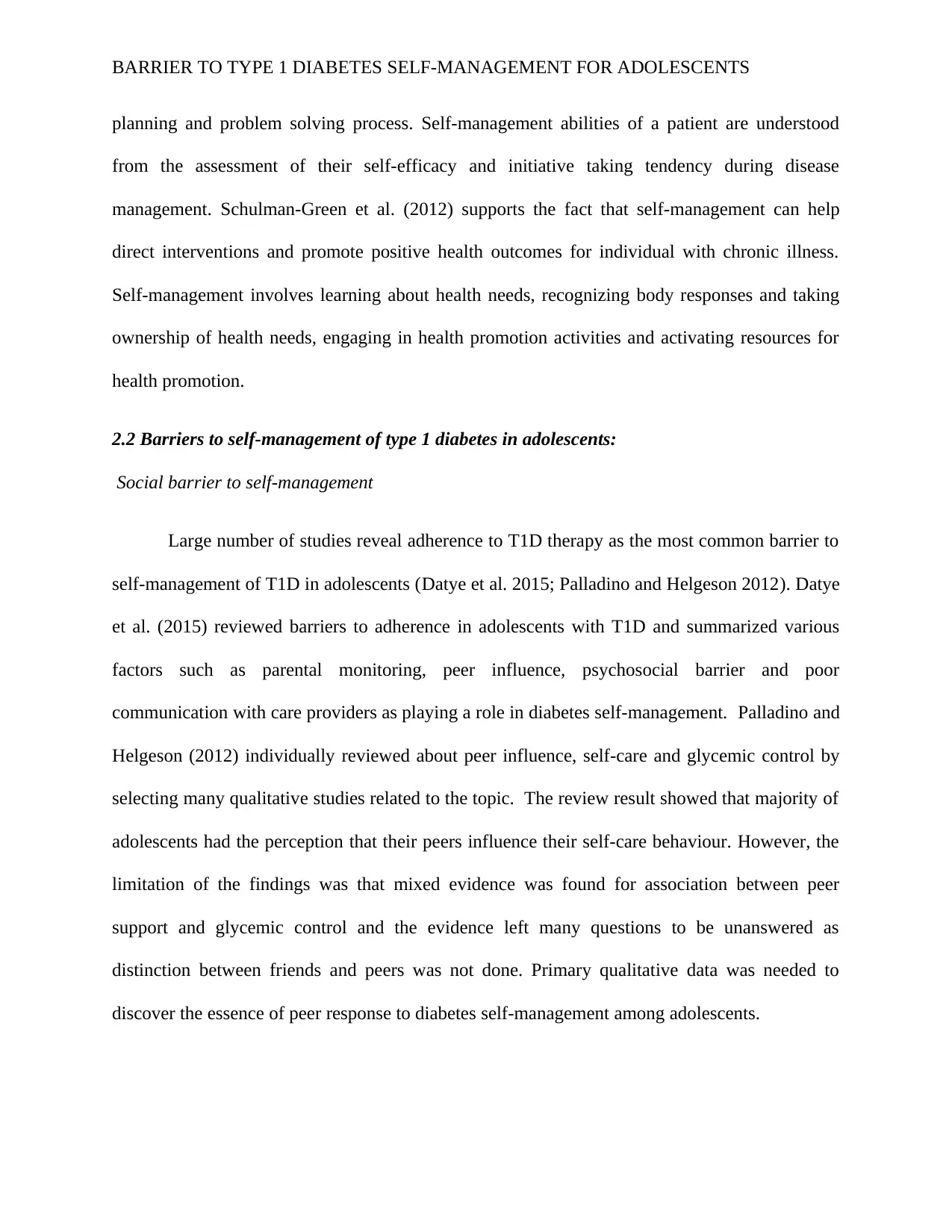
BARRIER TO TYPE 1 DIABETES SELF-MANAGEMENT FOR ADOLESCENTS
planning and problem solving process. Self-management abilities of a patient are understood
from the assessment of their self-efficacy and initiative taking tendency during disease
management. Schulman-Green et al. (2012) supports the fact that self-management can help
direct interventions and promote positive health outcomes for individual with chronic illness.
Self-management involves learning about health needs, recognizing body responses and taking
ownership of health needs, engaging in health promotion activities and activating resources for
health promotion.
2.2 Barriers to self-management of type 1 diabetes in adolescents:
Social barrier to self-management
Large number of studies reveal adherence to T1D therapy as the most common barrier to
self-management of T1D in adolescents (Datye et al. 2015; Palladino and Helgeson 2012). Datye
et al. (2015) reviewed barriers to adherence in adolescents with T1D and summarized various
factors such as parental monitoring, peer influence, psychosocial barrier and poor
communication with care providers as playing a role in diabetes self-management. Palladino and
Helgeson (2012) individually reviewed about peer influence, self-care and glycemic control by
selecting many qualitative studies related to the topic. The review result showed that majority of
adolescents had the perception that their peers influence their self-care behaviour. However, the
limitation of the findings was that mixed evidence was found for association between peer
support and glycemic control and the evidence left many questions to be unanswered as
distinction between friends and peers was not done. Primary qualitative data was needed to
discover the essence of peer response to diabetes self-management among adolescents.
planning and problem solving process. Self-management abilities of a patient are understood
from the assessment of their self-efficacy and initiative taking tendency during disease
management. Schulman-Green et al. (2012) supports the fact that self-management can help
direct interventions and promote positive health outcomes for individual with chronic illness.
Self-management involves learning about health needs, recognizing body responses and taking
ownership of health needs, engaging in health promotion activities and activating resources for
health promotion.
2.2 Barriers to self-management of type 1 diabetes in adolescents:
Social barrier to self-management
Large number of studies reveal adherence to T1D therapy as the most common barrier to
self-management of T1D in adolescents (Datye et al. 2015; Palladino and Helgeson 2012). Datye
et al. (2015) reviewed barriers to adherence in adolescents with T1D and summarized various
factors such as parental monitoring, peer influence, psychosocial barrier and poor
communication with care providers as playing a role in diabetes self-management. Palladino and
Helgeson (2012) individually reviewed about peer influence, self-care and glycemic control by
selecting many qualitative studies related to the topic. The review result showed that majority of
adolescents had the perception that their peers influence their self-care behaviour. However, the
limitation of the findings was that mixed evidence was found for association between peer
support and glycemic control and the evidence left many questions to be unanswered as
distinction between friends and peers was not done. Primary qualitative data was needed to
discover the essence of peer response to diabetes self-management among adolescents.
Paraphrase This Document
Need a fresh take? Get an instant paraphrase of this document with our AI Paraphraser
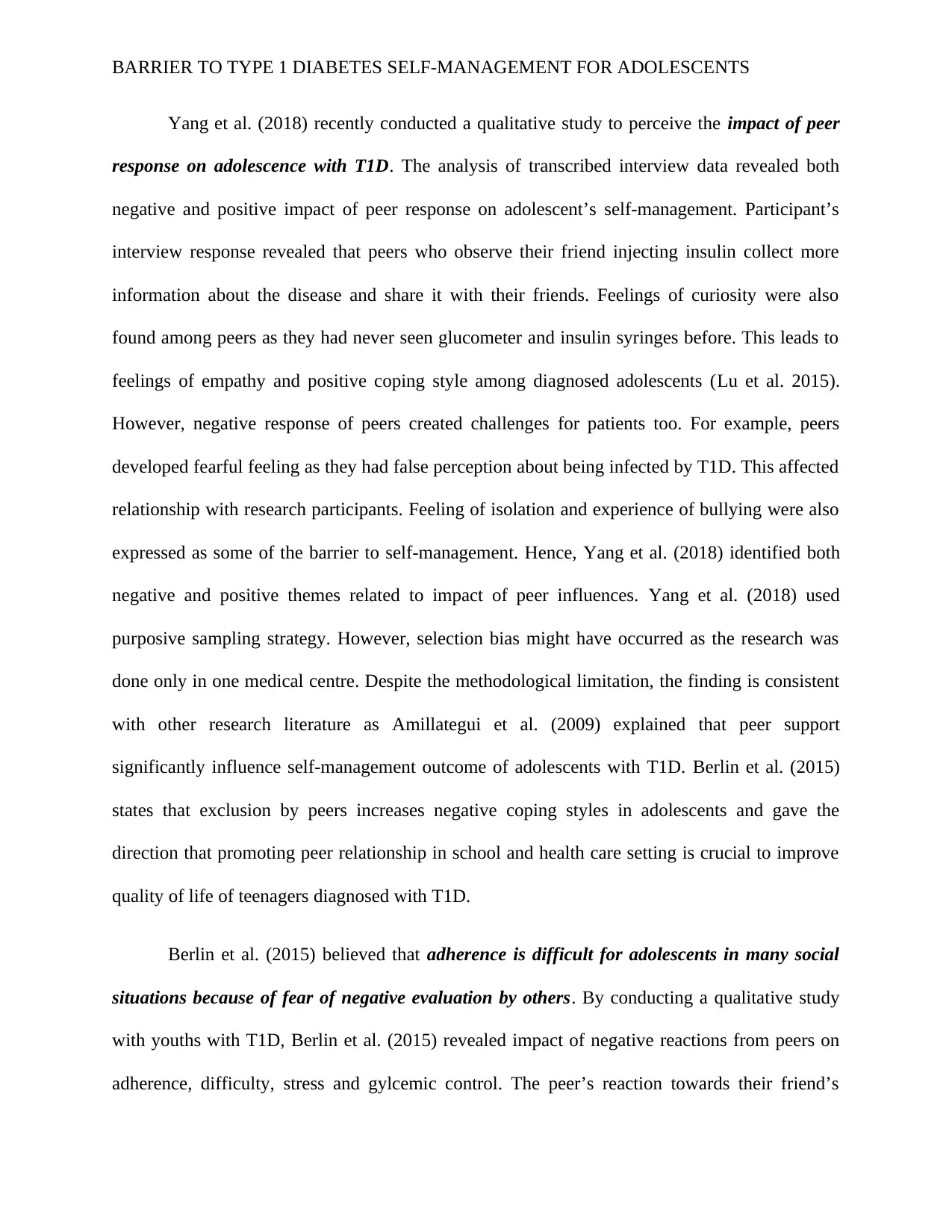
BARRIER TO TYPE 1 DIABETES SELF-MANAGEMENT FOR ADOLESCENTS
Yang et al. (2018) recently conducted a qualitative study to perceive the impact of peer
response on adolescence with T1D. The analysis of transcribed interview data revealed both
negative and positive impact of peer response on adolescent’s self-management. Participant’s
interview response revealed that peers who observe their friend injecting insulin collect more
information about the disease and share it with their friends. Feelings of curiosity were also
found among peers as they had never seen glucometer and insulin syringes before. This leads to
feelings of empathy and positive coping style among diagnosed adolescents (Lu et al. 2015).
However, negative response of peers created challenges for patients too. For example, peers
developed fearful feeling as they had false perception about being infected by T1D. This affected
relationship with research participants. Feeling of isolation and experience of bullying were also
expressed as some of the barrier to self-management. Hence, Yang et al. (2018) identified both
negative and positive themes related to impact of peer influences. Yang et al. (2018) used
purposive sampling strategy. However, selection bias might have occurred as the research was
done only in one medical centre. Despite the methodological limitation, the finding is consistent
with other research literature as Amillategui et al. (2009) explained that peer support
significantly influence self-management outcome of adolescents with T1D. Berlin et al. (2015)
states that exclusion by peers increases negative coping styles in adolescents and gave the
direction that promoting peer relationship in school and health care setting is crucial to improve
quality of life of teenagers diagnosed with T1D.
Berlin et al. (2015) believed that adherence is difficult for adolescents in many social
situations because of fear of negative evaluation by others. By conducting a qualitative study
with youths with T1D, Berlin et al. (2015) revealed impact of negative reactions from peers on
adherence, difficulty, stress and gylcemic control. The peer’s reaction towards their friend’s
Yang et al. (2018) recently conducted a qualitative study to perceive the impact of peer
response on adolescence with T1D. The analysis of transcribed interview data revealed both
negative and positive impact of peer response on adolescent’s self-management. Participant’s
interview response revealed that peers who observe their friend injecting insulin collect more
information about the disease and share it with their friends. Feelings of curiosity were also
found among peers as they had never seen glucometer and insulin syringes before. This leads to
feelings of empathy and positive coping style among diagnosed adolescents (Lu et al. 2015).
However, negative response of peers created challenges for patients too. For example, peers
developed fearful feeling as they had false perception about being infected by T1D. This affected
relationship with research participants. Feeling of isolation and experience of bullying were also
expressed as some of the barrier to self-management. Hence, Yang et al. (2018) identified both
negative and positive themes related to impact of peer influences. Yang et al. (2018) used
purposive sampling strategy. However, selection bias might have occurred as the research was
done only in one medical centre. Despite the methodological limitation, the finding is consistent
with other research literature as Amillategui et al. (2009) explained that peer support
significantly influence self-management outcome of adolescents with T1D. Berlin et al. (2015)
states that exclusion by peers increases negative coping styles in adolescents and gave the
direction that promoting peer relationship in school and health care setting is crucial to improve
quality of life of teenagers diagnosed with T1D.
Berlin et al. (2015) believed that adherence is difficult for adolescents in many social
situations because of fear of negative evaluation by others. By conducting a qualitative study
with youths with T1D, Berlin et al. (2015) revealed impact of negative reactions from peers on
adherence, difficulty, stress and gylcemic control. The peer’s reaction towards their friend’s
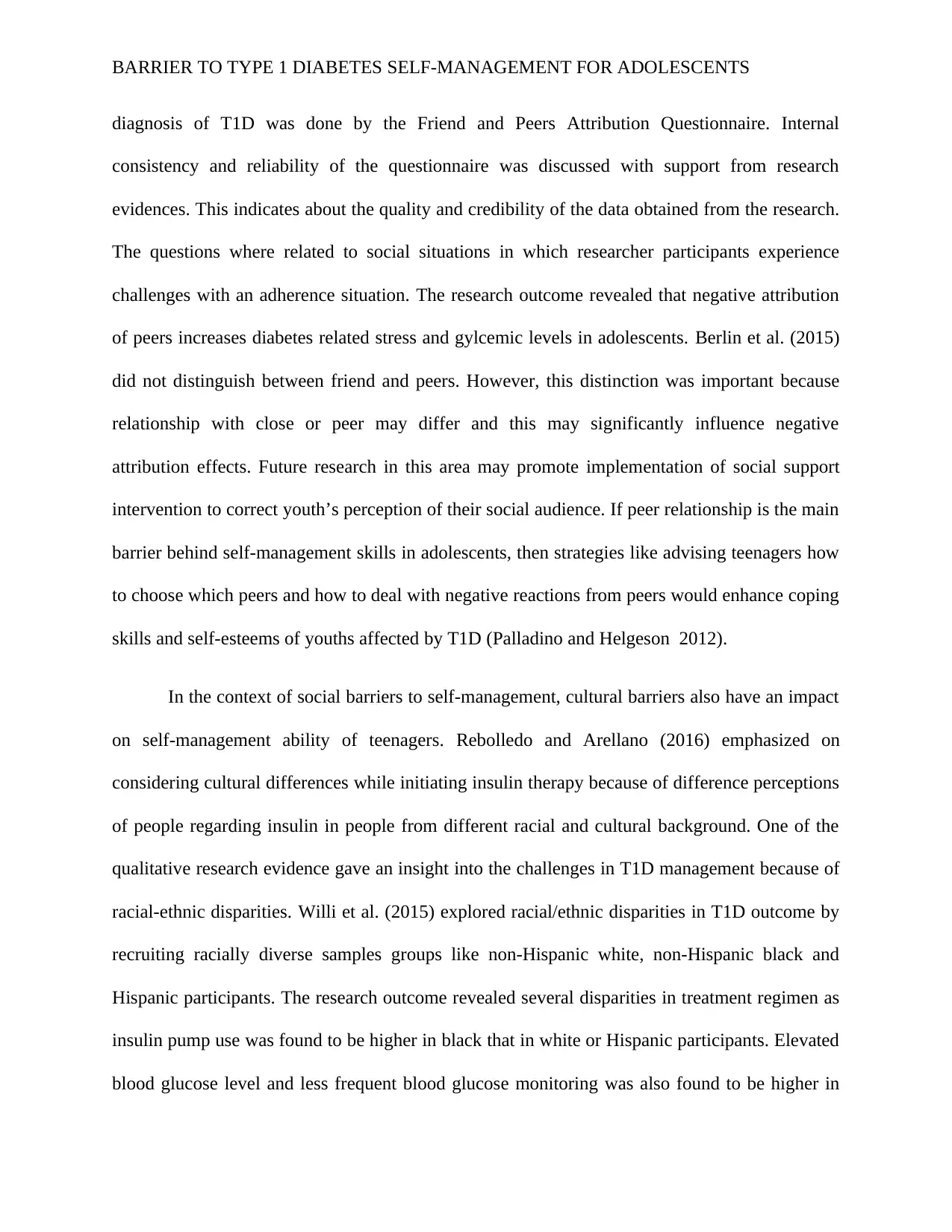
BARRIER TO TYPE 1 DIABETES SELF-MANAGEMENT FOR ADOLESCENTS
diagnosis of T1D was done by the Friend and Peers Attribution Questionnaire. Internal
consistency and reliability of the questionnaire was discussed with support from research
evidences. This indicates about the quality and credibility of the data obtained from the research.
The questions where related to social situations in which researcher participants experience
challenges with an adherence situation. The research outcome revealed that negative attribution
of peers increases diabetes related stress and gylcemic levels in adolescents. Berlin et al. (2015)
did not distinguish between friend and peers. However, this distinction was important because
relationship with close or peer may differ and this may significantly influence negative
attribution effects. Future research in this area may promote implementation of social support
intervention to correct youth’s perception of their social audience. If peer relationship is the main
barrier behind self-management skills in adolescents, then strategies like advising teenagers how
to choose which peers and how to deal with negative reactions from peers would enhance coping
skills and self-esteems of youths affected by T1D (Palladino and Helgeson 2012).
In the context of social barriers to self-management, cultural barriers also have an impact
on self-management ability of teenagers. Rebolledo and Arellano (2016) emphasized on
considering cultural differences while initiating insulin therapy because of difference perceptions
of people regarding insulin in people from different racial and cultural background. One of the
qualitative research evidence gave an insight into the challenges in T1D management because of
racial-ethnic disparities. Willi et al. (2015) explored racial/ethnic disparities in T1D outcome by
recruiting racially diverse samples groups like non-Hispanic white, non-Hispanic black and
Hispanic participants. The research outcome revealed several disparities in treatment regimen as
insulin pump use was found to be higher in black that in white or Hispanic participants. Elevated
blood glucose level and less frequent blood glucose monitoring was also found to be higher in
diagnosis of T1D was done by the Friend and Peers Attribution Questionnaire. Internal
consistency and reliability of the questionnaire was discussed with support from research
evidences. This indicates about the quality and credibility of the data obtained from the research.
The questions where related to social situations in which researcher participants experience
challenges with an adherence situation. The research outcome revealed that negative attribution
of peers increases diabetes related stress and gylcemic levels in adolescents. Berlin et al. (2015)
did not distinguish between friend and peers. However, this distinction was important because
relationship with close or peer may differ and this may significantly influence negative
attribution effects. Future research in this area may promote implementation of social support
intervention to correct youth’s perception of their social audience. If peer relationship is the main
barrier behind self-management skills in adolescents, then strategies like advising teenagers how
to choose which peers and how to deal with negative reactions from peers would enhance coping
skills and self-esteems of youths affected by T1D (Palladino and Helgeson 2012).
In the context of social barriers to self-management, cultural barriers also have an impact
on self-management ability of teenagers. Rebolledo and Arellano (2016) emphasized on
considering cultural differences while initiating insulin therapy because of difference perceptions
of people regarding insulin in people from different racial and cultural background. One of the
qualitative research evidence gave an insight into the challenges in T1D management because of
racial-ethnic disparities. Willi et al. (2015) explored racial/ethnic disparities in T1D outcome by
recruiting racially diverse samples groups like non-Hispanic white, non-Hispanic black and
Hispanic participants. The research outcome revealed several disparities in treatment regimen as
insulin pump use was found to be higher in black that in white or Hispanic participants. Elevated
blood glucose level and less frequent blood glucose monitoring was also found to be higher in
⊘ This is a preview!⊘
Do you want full access?
Subscribe today to unlock all pages.

Trusted by 1+ million students worldwide
1 out of 43
Related Documents
Your All-in-One AI-Powered Toolkit for Academic Success.
+13062052269
info@desklib.com
Available 24*7 on WhatsApp / Email
![[object Object]](/_next/static/media/star-bottom.7253800d.svg)
Unlock your academic potential
Copyright © 2020–2025 A2Z Services. All Rights Reserved. Developed and managed by ZUCOL.





